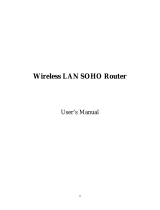
v
Contents
1 Quick setup ............................................................................................................................ 1
1.1 AP mode ................................................................................................................................... 1
1.2 Client mode .............................................................................................................................. 5
1.3 Example of AP mode and client mode ..................................................................................... 8
1.4 Universal repeater mode ....................................................................................................... 13
1.5 Example of universal repeater mode ..................................................................................... 16
1.6 WISP mode ............................................................................................................................. 19
1.7 Example of WISP mode .......................................................................................................... 23
1.8 Repeater mode ...................................................................................................................... 28
1.9 P2MP mode ............................................................................................................................ 38
1.10 Example of repeater mode and P2MP mode....................................................................... 43
1.11 Router mode ........................................................................................................................ 50
1.12 Example of router mode ...................................................................................................... 52
2 Web UI ................................................................................................................................. 55
2.1 Login ....................................................................................................................................... 55
2.2 Logout .................................................................................................................................... 57
2.3 Web UI layout ......................................................................................................................... 58
2.4 Common buttons ................................................................................................................... 58
3 Status ................................................................................................................................... 59
3.1 System status ......................................................................................................................... 59
3.2 Wireless status ....................................................................................................................... 62
3.3 Statistics ................................................................................................................................. 64
4 Network ............................................................................................................................... 69
4.1 LAN setup ............................................................................................................................... 69
4.2 MAC clone .............................................................................................................................. 76
4.3 DHCP server ........................................................................................................................... 78
4.4 DHCP client............................................................................................................................. 80
4.5 VLAN settings ......................................................................................................................... 81
5 Wireless ................................................................................................................................ 85
5.1 Basic ....................................................................................................................................... 85
5.2 Advanced .............................................................................................................................. 113
5.3 Access control ...................................................................................................................... 116




















